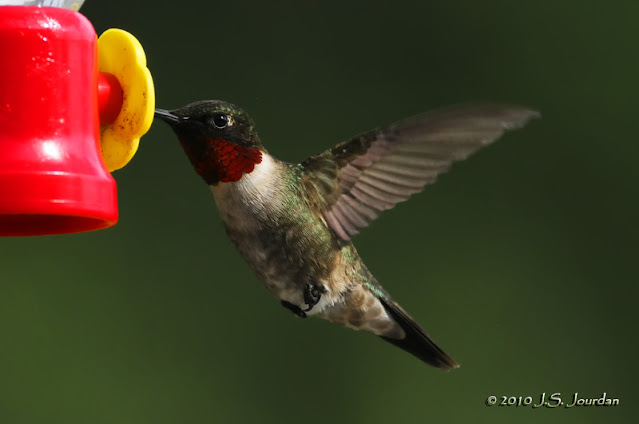Ruby-throated Hummingbirds - 05 Jun 2010
I was using a five flash system: A Nikon SB-800 (master) on my D300, two Nikon SB-600 (slaves) and two Nissin Di622 (slaves). The SB-600's and Di622's were supposed to trigger wirelessly when I triggered the SB-800 atop the D300. With 2 flashes in front of a feeder and two behind I was hoping to reduce/eliminate shadows off the birds.
Jo and Jay have several feeders around their back deck: two on kitchen windows, one on the deck sliding door, and a couple mounted in hanging flower baskets. I removed these feeders and placed them behind the gas grill in the corner of the deck. Jo and I were having a cup of coffee and watched as first a female, then male, appeared and looked for the feeders. It was cute to watch them buzz inches away from the sliding door in front of us looking the for the feeder, then spot the feeders in the corner of the deck. They wouldn't fly into the corner of the house, so they retreated to the only feeder left - one I set up around the hanging feeders.
I took a seat at the porch table about 10 feet away from the feeder and waited for them to come into feed. I let them feed several times w/o attempting to photographing them - I didn't want to scare them away. The first time I photographed the male it spooked at the sound of the camera and the flash, but quickly adapted.
The experts suggest photographing the birds after they feed, when they hover backward away from the feeder for a moment before flying off (or returning to feed). I observed the female do this several times, but the male would only come in once, feed, then fly off quickly. Because the female may be carrying eggs, I decided not to try to photograph her. Curiously, she only came around to feed about once an hour. The male would come approximately 10 - 15 minutes. I would let him feed for several seconds before firing away with the flash.
Because the Nissin flashes require the Master flash to be set to iTTL (on Nikon systems) I'm assuming that it was bright enough out to prevent them from firing. I can only guess that this is the reason they didn't go off. This, or maybe the flash was not triggering the IR units on the flashes. When one or two flashes did trigger the images were overexposed. So I was lucky they didn't fire.
It turned out that I didn't need flashes this morning. The last set of 12 or so images were shot in Continuous mode w/o flash. I was still able to capture some of the bright red gorget on the male's throat, but the correct use of flash would've really made it pop.
It turned out that I didn't need flashes this morning. The last set of 12 or so images were shot in Continuous mode w/o flash. I was still able to capture some of the bright red gorget on the male's throat, but the correct use of flash would've really made it pop.
3154 O'Hara Road, Carleton, MI, Monroe, Michigan, US
Jun 5, 2010 10:00 AM - 10:50 AM
Protocol: Stationary
Checklist Comments: Yard
1 species
Ruby-throated Hummingbird (Archilochus colubris) 2
View this checklist online at https://ebird.org/checklist/S1
This report was generated automatically by eBird v3 (https://ebird.org/home)
Jun 5, 2010 10:00 AM - 10:50 AM
Protocol: Stationary
Checklist Comments: Yard
1 species
Ruby-throated Hummingbird (Archilochus colubris) 2
View this checklist online at https://ebird.org/checklist/S1
This report was generated automatically by eBird v3 (https://ebird.org/home)








Yes, I will always strive to learn from you, and yet I will never be embarrassed that I will never match your exceptional abilities. I just love the fact you help me on the road as I follow you. You are getting shots that excel even your own! Thanks so much for sharing! Wow!!!
ReplyDelete- "Dr. Bob"